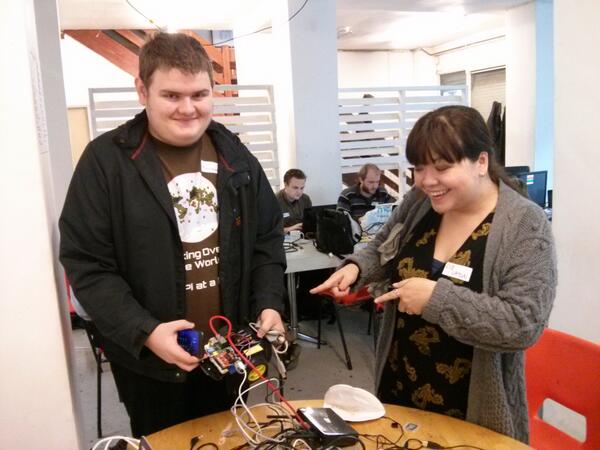| We first met Ryan Walmsley when he was fifteen, back in May 2012. He’d been emailing and tweeting with us for months at that point (mostly variations on WHEN CAN I BUY ONE?), and he then proceeded to knock our socks off very shortly after we started shipping by producing, out of the blue, the Rastrack map, which Pi users can register their Pis on, showing the geographical spread of the project. We still use Rastrack regularly: it’s a great visual aid at talks and workshops. At that point, Ryan had only really worked on web programming, but since buying his (first) Pi he’s gone on to learn Python, has done a huge amount of work on electronics and physical computing, and has been running Raspberry Jams in Stevenage, all while studying at sixth-form college. Ryan’s a really important part of the Raspberry Pi community. We rely on the passion, enthusiasm and skill of people like Ryan to get the word about Raspberry Pi out, and we think he’s great. Once he’d done a bit of dabbling with a soldering iron, we discovered that Ryan had a bit of a gift for electronics, and he’s visited Pi Towers a couple of times since we moved into our new offices to give us a hand adapting 1980s educational robots to work with Raspberry Pi. (Lots of schools still have discontinued equipment hanging around in cupboards.) He’s coming back in January for some formal work experience, and we are preparing to set him to work on some office-automation hacking when he gets here. We encouraged him to put his expertise to work in the meantime by contributing to the add-on board ecosystem, and so Ryan has developed something he himself felt was missing: a cheap, simple, solder-it-yourself motor controller board. RTK-000-001 is a very straightforward, inexpensive motor controller for the Raspberry Pi, designed for hobbyist and schools robotics. It can drive two DC motors at 0.5A each, which screw into terminals on the board. The board itself clips neatly to the top of the Pi, and you can then mount the whole assembly on a robot of your choice. Ryan’s made demo code available, so you can get started right away: in under 25 lines of Python you can get your robot spinning in alternate directions at five-second intervals, and it’s easy to progress from there to start programming it yourself. Ryan has a Tindie running to get the fifty orders he needs to get the price to the low level he thinks the RTK-000-001 should sell at. Please think about ordering one yourself: we get very excited when we see young people like Ryan building businesses around the Raspberry Pi, and we’re looking forward to using the board in our own offices. (Ryan, I have plans for getting you motorising all *kinds* of stuff in January. Our life-sized Minecraft sword would be 100% better if it started spinning on the wall when sent a command.) |
A Semi-automated Technology Roundup Provided by Linebaugh Public Library IT Staff | techblog.linebaugh.org
Tuesday, November 19, 2013
Ryanteck’s RTK-000-001 motor controller – robotics on a budget
Subscribe to:
Post Comments (Atom)

No comments:
Post a Comment